Arcona 340
Swedish styling and speed successfully combine in this new racer-cruiser
Arcona Yachts is relatively unknown in the United States, but it has developed quite a following in Europe. The Arcona 430 won the 2009 European Yacht of the Year, and all of its models are well respected on both the race course and in far-flung cruising anchorages.
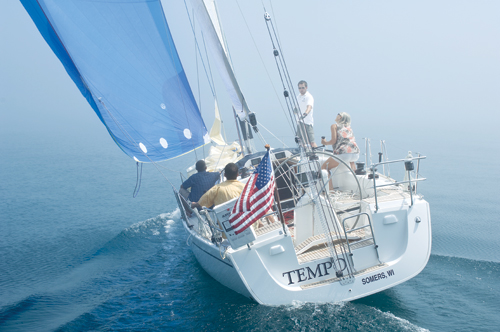
Arcona builds yachts in Kungshamn, Sweden, and it opened a new plant in Estonia about 10 years ago. The move to Estonia was economically driven, and the company wanted to take advantage of the lower labor rates. In truth, the yard is hardly Estonian. It is on the Baltic island of Saaremaa, which was a Swedish territory until about 150 years ago, and Swedish is still spoken there. The yard's management is also Swedish. Boatbuilding in Estonia is well established, and Swan builds its class 42 there. Arcona has managed to get lower labor rates while maintaining a uniquely Swedish environment. The company builds about 50 boats a year, making it the third largest builder
in Sweden.
The Arcona 340, designed by Stefan Qviberg, is placed right at the sweet spot for a racer-cruiser, successfully competing against the other 10-meter boats of the world, but doing so with a bit more comfort and understated Scandinavian elegance.
I had the opportunity to sail the Arcona 340 Tempo on Lake Michigan off Kenosha, Wisconsin. The boat is owned by Sam and Paula Waller, who worked directly with the U.S. Arcona dealer Gunnar Vagenius to import the boat. Since this was the first boat in the country, the trio took a trip to Sweden to do a test sail. The Wallers owned a Tartan 3700 and were looking for a more performance-oriented boat that was also comfortable to cruise. The 340 fit the bill nicely, and they are building a fun but competitive race campaign around it with friends and family. I actually had the pleasure to sail with the Wallers twice, and the boat is working out as a great platform for their rapidly developing crew.
The details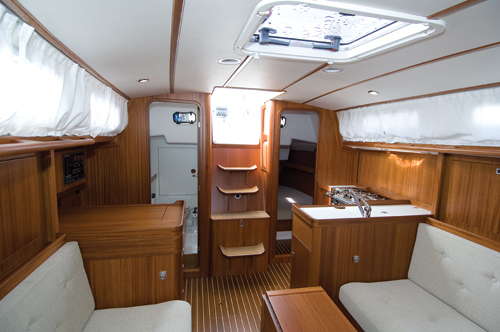
The cosmetics of the 340 are classic Scandinavian, with conservative lines and a performance edge. The hull has a flat sheer, short overhangs and moderate wetted surface, giving a long, slippery waterline but enough hull form to provide a soft motion at sea. The bow is fairly plumb and the boat terminates with a fairly open transom and small swim step. To give volume below, the cabinhouse is relatively tall, but it does not detract from the look of the boat at all.
The 340 has a 6-foot, 6-inch draft. The keel consists of an iron fin fitted with a cast lead bulb, keeping the center of gravity low. It is through-bolted with 10 20-millimeter stainless steel bolts. The rudder is high aspect and supported by Jefa self-adjusting rudder bearings.
The hull is formed with a vacuum foil infusion process, ensuring even resin distribution and full wet-out. The process yields a strong and stiff hull while keeping the weight as light as possible. The laminate is multiaxial roving and vinylester, all cored with high-density Divinycell. The hull and deck are cored to add stiffness and keep the weight down, but solid laminate in used around the keel, rudder and hull fittings.
A unique aspect of the hull is the galvanized steel framework used in the hull's interior. The framework carries and transports the loads of the keel and rig to the hull. To further stiffen the hull, the bulkheads and interior are fully tabbed to the hull, not just carried in the liner.
On deck
The cockpit is wonderful place to sail-very workable for a race crew, but also designed for easy cruising. The large, five-spoke Jefa wheel is mounted on a low-profile fiberglass pedestal topped with a stainless guard that provides a handhold as well as protection for a chartplotter. The traveler is mounted just forward of the helm on an elevated bridge.
The helm is very functional. There are teak-covered seats outboard on the comings, and the test boat was customized with an elevated step to allow shorter drivers a clear view. The transom is just open enough to be sporty, and to clear boarding seas, but not so much that you feel exposed. Forward of the traveler are short settees. The cockpit is fairly wide, but the test boat was customized with a solid teak foot support through the middle of the cockpit sole, a very welcome addition when the wind pipes up.
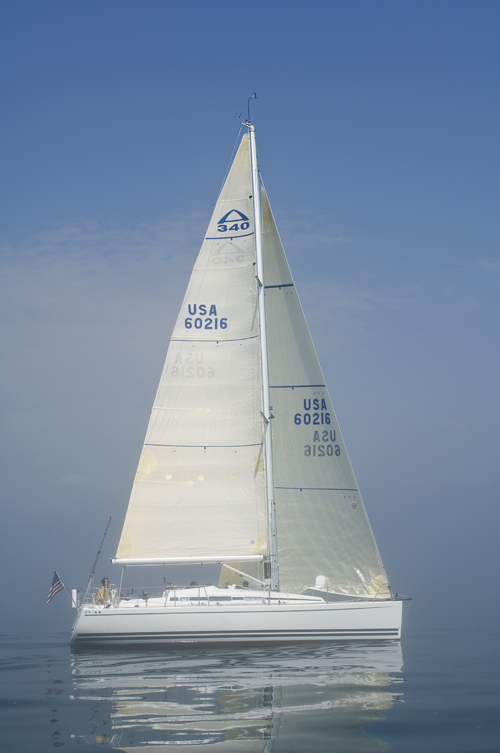
Farther forward, there is nice recess to hold the folded frame and canvas of the dodger. All the control lines lead aft to a bank of clutches at the cabintop. The lines are led aft under deck to minimize clutter.
The deck molding and nonskid are top-notch. I would have liked to see a bit more nonskid on the cabin-house deck. The smooth fiberglass looks nice, but can be slippery when working around the mast. All the halyards are led aft, but the truth is that you'll still spend a lot of time working around the mast.
Storage on deck is generous, with deep twin lockers on the aft quarters and a very large, deep lazarette on starboard. The lazarette is also accessible from a panel in the head, making it far more usable. There is a large anchor locker accessible on the foredeck.
The boat has a double-spreader Selden aluminum spar, and the test boat had optional Dyform wire to minimize a bit of weight. The rig is fractional with an optional masthead spinnaker. The backstay is easily adjustable from the helm with a triple cascaded tackle. The mainsheet is setup Admiral's Cup style, with winches just forward of the helm. The deck package is very nice, a combination of Selden and Lewmar, using very nice Harken Radial winches.
Arcona did a very nice job with the asymmetrical tack line and the removable sprit. Many builders seem to tackle these items without a lot of elegance-you'll see the tack line flop around deck and can chafe on the furler and pulpit when deployed, and sprits are sometime clumsily mounted via the anchor roller. In contrast, Arcona handled the tack line very nicely; it almost magically emerges from a chafe-free port right below the stem fitting and is led back to the cabintop stoppers below deck. The sprit, a carbon fiber model from Selden, mounts on the foredeck and is led through a hoop integrated into the bow pulpit. The outboard end is supported with a Dyneema line that retracts into the hull when not in use. All very slick, and the sprit is completely removable at the end of the race day. The sprit is designed to carry an asymmetrical chute or a code zero on a continuous line drive furler. The test boat used a great furling unit from Selden.
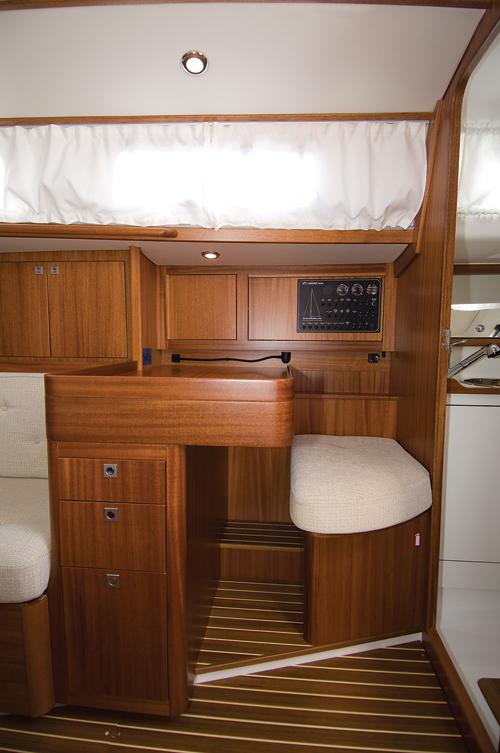
The below-deck jib furler is very nicely done. Most below-deck units force a large hole in the deck, looking ungainly and resulting in a spot to catch lots of water. The 340 uses the Furlex TD (through deck) furler. This unit puts the drum below deck, and the tack fitting right on the deck. With no exposed hole at all, the end result is a very clean look. The benefits go beyond looks; with the tack fitting on the deck, the sail can be cut very low. Yes, you can have a furler and a deck-sweeping jib. The boat was originally designed to sail nicely with a 110% No. 3, and it actually sheets inboard of the shrouds for tight reaching angles.
Down below
One look at the interior of the 340 and there is no doubt that this is a Swedish boat. The interior is lined with silky smooth satin finished mahogany. The cosmetics of the interior just ooze understated Scandinavian design.
The interior is a traditional layout with few surprises. As you step down the companionway, the nav station is on starboard and the galley on port. Forward, there are opposing settees flanking a centerline folding dining table. Sleeping cabins are in the forepeak, with a large aft cabin on port. The head is just aft of the nav station.
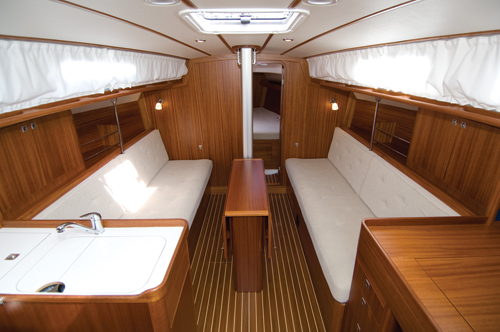
There is just over 6 feet of standing headroom at the aft end of the saloon, in the head and the aft cabin. Headroom drops to 5 feet, 7 inches going forward. The galley is L-shaped, with an Eno two-burner propane stove outboard, an IsoTherm refrigeration compartment forward of it, and a small double sink to center. The galley is very workable, with a reasonable amount of countertop space and ample storage in drawers and lockers.
The nav station is forward-facing with a large work area for paper charts. There is ample panel space for electronics, and a very nice breaker panel. A peek inside the breaker panel shows very nicely done wiring, with numbered wire tags on every terminal. There is storage below the work surface and a bank of drawers.
The head is a nicely trimmed in white fiberglass and laminate with mahogany trim. A highlight of this compartment is the large access panel to the starboard cockpit lazarette. There is a unique hanging wet locker integrated into the head cabinetry.
Ventilation in the boat is good. There are two large deck hatches, the large companionway, and opening portlights in the saloon, aft cabin and head.
The boat has a 20-horsepower Yanmar 3YM20C. Access to the engine is very good. Fuel tankage is 30 gallons and there are 60 gallons of water. The tankage is very reasonable for a performance cruiser of this size.
Under sail
I did not have ideal conditions to sail the 340, as it was foggy, light and fluky. With that said, those conditions are great for assessing the sailing abilities of a boat. Face it, most boats sail pretty well when the wind pipes up, but it takes a good design to shine in less than ideal conditions.
As we motored out of Southport Marina, the first thing I sensed was the fingertip control on the helm. The large, low-mass wheel is effortless in your hand yet very responsive. The Jefa steering system and rudder bearings are silky smooth. The helm is responsive but not twitchy in any way; the boat tracks well. The 20-horse Yanmar is very smooth and moves the boat nicely. In the flat water, we motored nicely at about 6 knots and were flirting with 8 knots with a wide-open throttle.
After tacking around for a bit we found a little breeze. With about 10 knots over the deck we could sail about 30 degrees off in the sixes. The boat accelerated nicely as we found little puffs and pushed through the holes with a bit of momentum. We cracked off a bit and hoisted the big asymmetrical. This sail allowed the boat to hit its stride with peak speeds in the 7-knot range.
I was really impressed with the clean spinnaker deck rigging; the trick tack line and pole setup works just as nicely as it looks. The headstay is pulled back a bit from the stem, so even without the optional sprit the stem-mounted tack line gives just enough room to easily jibe the asymmetrical.
This was the first boat I had sailed with Harken Radial winches. The fluted drum performed well, with lots of smooth power, and three wraps secured things, but you could easily surge and release too.
The boat feels really good under sail. The silky steering performs perfectly under sail, and from my perch on the leeward rail, I could easily sail with just two fingers. The feel of the helm was great.
Keep your eyes open for Arcona at the boat shows and on your local race course. A fully equipped boat with delivery from Sweden goes for around $220,000 (base boat price of $178,000 F.O.B. Gutavsberg, Sweden). The winning formula of a comfortable, well-built boat that sails well and is just plain fast is hard to ignore.
Arcona 340
LOA 34'1"; LWL 30'4"; Beam 11'4"; Draft 6'6"; Ballast 4,189 lbs.; Displacement 10,582 lbs.;
Sail Area 785 sq. ft.
Base Boat Price $178,000
Gunnar's Yacht & Ship
P.O. Box 215
Oak Creek, WI 53154
(414) 764-3994
www.yachtworld.com/gys

Comments